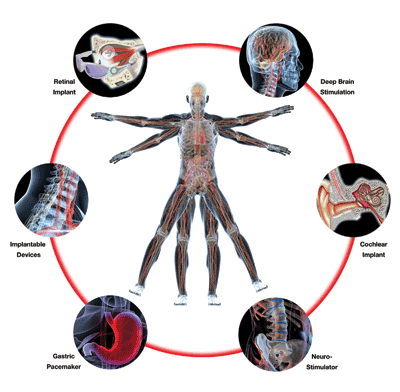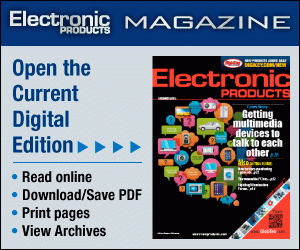Medical trends: A look ahead to the year 2029
Predicting the future of the medical electronics industry
BY DOUG RASOR
Texas Instruments, Dallas, TX
http://www.ti.com
and MIR IMRAN
InCube Labs, San Jose, CA
http://www.incubelabs.com
Medical electronics have come a long way in the last 30 years. Looking back to the invention of the implantable defibrillator in 1980, balloon angioplasty in 1982 and the coronary stent in the mid-1990s, we start to see the significant role technology has played in making devices that allow medical professionals to treat diseases with an increasing level of accuracy and certainty.

Electronics inside the human body.
If the pace of innovation during the last three decades has been swift, the pace during the next 20 years will be nothing short of incredible. We have only scratched the surface of potential when it comes to the field of medical electronics.
Predicting the future
The best way to identify future medical trends is to look at what is in the innovation pipeline today. Many of the technologies that will become standards of care in the year 2029 have already been introduced to the medical community. Time for clinical trials, FDA approvals, community research reimbursement, and other factors will bring these innovations to adoption and implementation on a worldwide scale.
Some dramatic changes will occur in the areas of personalized medicine, implantable devices and optical techniques. However, the requirements for effectively deploying and managing the wireless devices that are part of these medical solutions are highly dependent on the size of the network the device interacts with, the amount of data to be transmitted, the overall device size, and the required transmit range.
The criticality of the solution’s purpose is a key factor to eliminating the impact of interferers. While wireless interfaces like Wi-Fi or WLAN, Bluetooth and Bluetooth low-energy lend themselves to larger network implementations, especially the ability for this low-energy technology to leverage many of the components already used in Bluetooth technology, the range and number of interferers in the device’s operating environment can make their use problematic in some applications.
As a result, many implantable and critical care devices will require proprietary solutions that provide better control and understanding of their EMI sensitivity and range requirements. At this time, the Continua Alliance is moving forward with Bluetooth low-energy and Zigbee as their choices for a wireless solution platform.
Personalized medicine
In our society today, we have a “sick care” system, not a healthcare system. During the next 15-20 years, technology innovations will shift more investment and responsibility in the areas of wellness and early detection and prevention into the hands of the consumer.
Within the next two decades, a significant part of the world’s population will have the ability to monitor their own health using diagnostic devices that contain imaging- and non-imaging modalities. For example, a gastric pacemaker could be implanted within the human body to treat obesity and alcohol addiction. A digital band-aid may be used to monitor a wound’s status and report signs of infection. High-performance sensors built into toilets could continually measure the level of bacteria in a person’s urine and stools and warn them of the onset of infection and other diseases. And this is only the beginning.
Cell phones can serve as a powerful platform for giving individuals and their healthcare providers immediate feedback based on pre-determined parameters. Twenty years from now, the cell phones of people with diabetes may have the ability to warn them and their doctors of the onset of diabetic shock before the person begins experiencing actual symptoms. There are hundreds of different applications where medical technology can be used to provide patients the ability to monitor wellness and initiate self-care.
Data integrity and access, along with system flexibility and mobility, are important to most patient monitoring systems. Interfaces such as Ethernet or wireless allow hospitals to network all of the equipment in the building, as well as a patient’s home. Today’s interfaces allow doctors to remotely connect to a patient via a wireless sensor pack worn by the patient, leveraging a hospital’s internal network or links to the patient’s home security system or cell phone. The entire system ties into the Ethernet or a medical call center to receive around the clock monitoring in the privacy of their home. Wireless interfaces such as Bluetooth and Zigbee also have a play here. Aside from power consumption, data rate and range are the two key requirements when selecting a wireless interface.
A higher-frequency range of 2.4 GHz provides worldwide coverage, a high data rate and duty cycle with many channels. But lower frequencies increase the signal range. For multi-channel, full-body monitoring, the range could be limited in a fixed location, but the data rate maximized. When monitoring just a few sensors, range may be more important than data rate. Ultimately, the solution choice must fit the system power budget and data transfer requirements.
Implantable devices
Every implantable device 20 years from now will use electronics to provide non-invasive assessment. For example, today the heart stent serves the singular function of unblocking an artery. In the future, the stent will be armed with a sensor equipped with RFID technology in its wall to provide wireless feedback about the vessel’s condition by simply passing a wand over the patient’s chest.
Artificial disks containing sensors will be implanted into a patient’s hip, spine or knee to non-invasively monitor how much force is being applied to the area and to determine if the implant is functioning correctly. If too much pressure is being applied, or if the implant is not working as it should, the sensor will proactively warn the patient and healthcare provider so that immediate adjustments can be made.
“Every implantable device 20 years from now will use electronics to provide non-invasive assessment.”
Today, high-performance sensors are not widely used in medical devices because the body’s proteins and immune system attack them and typically render them ineffective in a matter of hours. In the next two decades, cell biology will be used to prevent the body from rejecting the sensor as a foreign object. Biomaterial-compatible devices will become essential for all implantable devices.
Optical techniques
On the horizon, optical-coherent techniques will give medical professionals the ability to look at chemical changes in tissue. By characterizing tissues using certain absorption and reflection properties, doctors will be able to quickly and easily decipher normal from pre-cancerous tissue in a non-evasive manner. This technology will be especially useful when looking for dangerous conditions involving the esophagus, skin and mouth.
Spectroscopy will become widespread over the next 20 years for early detection of rectal polyps. A rectal optical probe will be inserted into the patient to determine with 100 percent accuracy whether he or she has rectal polyps and requires a colonoscopy.
With more than 100 million colonoscopies performed each year, this technology will ultimately decrease the number of procedures performed on patients who do not really need the procedure – thereby reducing healthcare costs. The less invasive nature of the probe will, at the same time, encourage patients who may be wary of having a colonoscopy to participate in a preventative screening that could ultimately save their life.
Another future optical technique will use long wave lengths of light for medical imaging beneath the skin. This technology will be used to see veins before administering intravenous lines, during laparoscopic surgery to differentiate a nerve from a blood vessel and much more. All of these technologies will be dependent on electronics, coupled with electro-optic devices like lasers and LEDs.
Stem cell therapies
No look into future medical trends is complete without a discussion of stem cell therapies, which will become commonplace in the next 20 years. As a scientific community, we are just now beginning to understand how to turn stem cells into different functional cell types. Devices are needed for harvesting and separating stem cells. Biochemical reactors that use electronics are needed to create the appropriate environment to differentiate the type of cell and place cells in the desired location.
Electronics will also play a critical role in the differentiation of cells into usable types. Technology innovations will be used to deliver cells back into the patient. Biomaterials will play a vital role in how we deliver cells into human organs for repair and regeneration.
The future looks bright
Innovation curves are hard to foresee and medical trends 20 years from now will likely be nothing like we are predicting today they will most likely be even more advanced. Innovations that we are not aware of today will become standards of care 10 years after that.
The field of medical technology is vast and holds infinite opportunity. While today a great deal of innovation is taking place in the U.S., global collaboration with Western Europe, Russia, Israel, China and India, for example, is helping to make these future trends a reality. ■
Advertisement
Learn more about Texas Instruments





